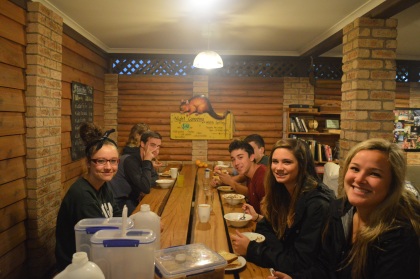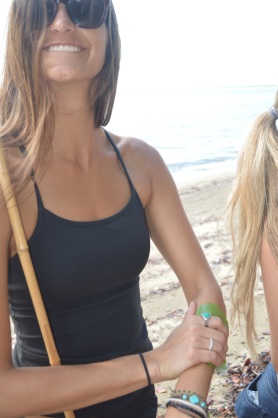Hi friends, family, and Mrs. Hill’s Class,
If you have been keeping up with our travels and blog you have seen how busy we have been with various different adventures!
On June 3rd, our adventures commenced at 6:30am with a breakfast of cereal and toast.
At 7:15am we traveled from Yungaburra up in the mountains down to Port Douglas on the shores of the Pacific Ocean. The Port Douglas area is known to be the place where the rainforest and reef meet.
Once in town, we met up with Linc Walker for a Cultural Aboriginal tour. Linc along with one of his brothers use their ancestral knowledge to educate visitors on Kuku Yalanji culture. We toured a traditional fishing ground of the Kuku Yalanji Bama called Cooya Beach, a territory comprised of great biological diversity. On the tour we were exposed to beaches, mangroves, coastal reefs, tidal lagoons, and mudflats. Linc’s home is located across from Cooya Beach, so we left from his house and went to the beach where he taught us how to throw spears. To properly throw a spear, you put the pointer finger of your dominant hand on the non pointed end of the spear and your other hand extended as far down the shaft as possible. You then put all your weight on your back foot while aiming at your target and shift forward throwing the spear.
After, we walked down the beach where Linc pointed out various plants and their medicinal uses. Such plants included hibiscus flower used for tea, mangrove vine used as an anti inflammatory, and cooling leaf which relieves sunburn. We continued down the beach where we entered a mangrove mud flat which was the entrance to the spear hunting grounds. The mudflat contained a variety of different wildlife, like mangrove mussels. Once past the mudflats we were in shallow ocean water about calf deep where we could begin hunting for mud crabs. Mud crabs live in holes in the sand and in the crevices of the mangrove root systems. If you were not lucky enough to find a mud crab out in the open, you would stick your spear down the crab hole to draw them into clear water. Finding mud crabs was difficult because the water was often murky from everyone walking around and the crabs moved very quickly. A total of 14 crabs were caught throughout the two hours we were hunting. When we were done, we went back to Linc’s house where he cooked our crabs and mussels for us to eat. We were then allowed to try green ants. Green ants taste slightly sour when only licking them, but act as a cold remedy when smashed up and sniffed.
A few of the victorious hunters!
We were extremely lucky to have the opportunity to learn to throw a spear, track coastal resources, and to go crab hunting, all while enjoying the other wildlife in the area thanks to the law passed in 1992. In 1992, the government passed a law called “Native Title” under Mabo which gave aboriginal people some of their land back and allowed them to hunt traditionally. The law said that aboriginal people were allowed to hunt what ever animal or sea creature they needed to sustain their lives or culture, even though it was illegal for non-aboriginals or any aboriginal outside of the territory to hunt on the land. A land use policy was also passed around the same time which forbid anyone to build on or near this beach. This allows anyone of Kuku Yalanji heritage to use the natural resources of the land. By passing these laws, the government gave aboriginal people the opportunity to reclaim and sustain their traditional culture.
Next we stopped at Daintree Ice Cream Company and enjoyed tropical fruit ice cream made from fruits grown locally at the adjacent farm. Since Daintree Ice Cream grows their own fruit, flavors of ice cream vary depending on the season. We had raspberry, mango, coconut, and wattleseed ice cream. Wattleseed is a native food and is a green and yellow plant. Australian athlete colors are based off of the wattleseed. While it seemed to be an interesting flavor, it actually tasted similar to hazelnut. By growing locally, the company helps the local economy and reduces the carbon footprint since they are not importing their products.
Finally the Steven Irwin inspired part of the day arrived! We got to go on the legendary Mangrove Croc Cruise. The cruise took place in Daintree National Park. During the tour we traveled through the mangroves starting from Cooper Creek’s Coral Sea Mouth, moving towards Queensland’s third largest mountain. While on the trip we saw a baby crocodile and a large female crocodile. The crocodiles we saw were Estuarine crocodiles, which are the largest of all living reptiles. Because our trip was later in the day, the air was cooler which meant the crocodiles moved into the water to stay warm. This did not allow us to view the entire body of the crocodile, but gave us a sufficient peak into their lives. Female crocodiles are territorial and stay within a one kilometer range for their entire lives. We also saw a few Egrets in flight and almost witnessed a crocodile eat one!

We finished the day with dinner at Cape Tribulation Beach House and a nice view of the Pacific Ocean!
Looking at the sustainability of our day, we witnessed a day that incorporated all three pillars; economics, social/political, and environmental. When spear hunting with Linc Walker we were amidst culture sustainability and economically sustainability. The 1992 law allows for aboriginal people to continue their traditions and eat locally which saves money. At Daintree Ice Cream we once again saw the benefits of buying and eating local through economic and environmental sustainability since there was no cost or carbon footprint of importing ingredients. Lastly, although riding in a boat up and down a river is not environmentally sustainable, it allowed us to see what we would lose if human pollution does not subside. By seeing the mangroves and crocodiles we were able to see the complex environmental systems.
It was a very successful day in the Australian environment!
Sources:
Aboriginal Tours- Insight about the tours offer by the Walker family and a glimpse into their culture.
http://bamaway.com.au/kuku-yalanji-cultural-habitat-tours/
Native Title- The law passed restoring native land to aboriginal people in Australia.
http://www.fedcourt.gov.au/law-and-practice/areas-of-law/native-title
Daintree Ice Cream- The ins and outs of the ice cream company and what they do.
http://www.daintreerainforest.com
Wattleseed- The type of native fruit used in the ice cream which was once a staple in aboriginal people’s diet.
http://tasteaustralia.biz/bushfood/wattleseed/
Crocodile Cruises- Background information about the cruise, including the route we took and information about the crocodiles.
http://www.capetribcruises.com/cruises.html
Estuarine Crocodile- The largest reptile in the world which lives in the Australian mangrove system.
https://www.australiazoo.com.au/our-animals/reptiles/crocodilians/saltwater-crocodile

















June 7, 2015 at 6:47 am
I really enjoyed this day! The spear fishing was a really unique opportunity. I also liked how they talked about using almost all of what they catch. It is very sustainable of them to share with the whole area or family what they catch that day. This everyone is fed and they have minimal amounts of the crabs wasted. It is also good because the men can hunt together, which keeps them in touch with their culture. The aboriginal people do an incredible job of using what’s around them to their advantage.
LikeLike
June 7, 2015 at 8:00 am
The whole group had a lot of fun this day! I particularly liked when Linc told us all of the different uses for particular species of plants and animals that can be found along the ocean. For example, one part of a plant can be used as a spear and another as a rope. I also found it interesting that his family all lives next door to each other or in the same area. When the Aboriginal people go to hunt for food, they only catch what they need. They feed the entire family and town and do not waste any food! This sustainable method should be adapted in multiple cultures to help food security issues. The ice cream we had was also so delicious! I loved that they grew the fruit right there on the farm then used them to make the ice cream! It was so fresh and had so much flavor!
LikeLike
June 7, 2015 at 10:24 am
This day was so fun! It was something I never would have done unless I was here. I enjoyed the spear fishing because we were able to see how the aboriginals lived. While on the beach, Linc showed us all the resources that they utilize for every day needs. They use pretty much everything that is available, unless it is poisonous of course. He told us that they always have something to eat because many of the plants on the beach are edible and they are allowed to fish anything in the waters. This makes their living sustainable because they are using the resources of the land to survive. They also are really big into preserving that land because they need that land to survive. The mangroves especially are very important to their culture. I really liked how we were able to cook what we caught that day too! The mussels and crab were really good. Lastly, I enjoyed eating the ice cream at the Daintree Ice Cream Company. Since it was made from local fruit, it tasted so refreshing. This is a much more sustainable option for making ice cream since it supports the local farmers. Overall, this day was so fun and informative since we got to see all the aspects of sustainability in one day.
LikeLike
June 7, 2015 at 11:19 am
Such a great summary of the day Becca! Even though I was not lucky enough to catch a crab, the cultural tour and spear fishing were my favorite. I especially enjoyed learning about the Native Title. One interesting thing Linc talked to is about was how when hunting, his family only takes exactly what they need that way there is no waste. This is a great sustainable practice because by not taking too many crabs or fish they allow those populations to remain to reproduce and they are not throwing away any food. I think this is a great thing to remember and that we should all try to only take as much as we need to reduce waste!
LikeLike
June 8, 2015 at 4:17 am
This was definitely one of the most memorable days of the trip. It was awesome to see how Aboriginals are utilizing their land in traditional ways. We have so much we can learn from the way aboriginals do things. If Australia can figure out how to incorporate Aboriginal traditions into everyday life, they will be much better off! It was a great learning experience and I think we all have a greater appreciation for where our food comes from. Catching crabs was not an easy task, but the end result was delicious! I thought it was interesting how the flavor of the crabs was much different than if you bought crabs in the grocery store at home. The crabs tasted much saltier but also fresher than grocery store crabs. Those two hours are something I will never forget and I can’t wait to share that experience with people in America! Great post Becca
LikeLike